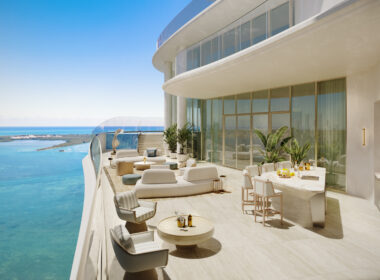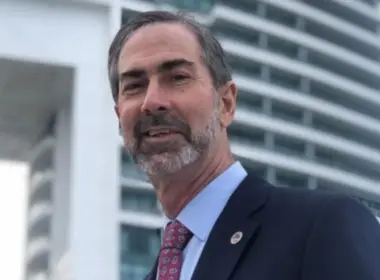How furniture-maker Kannoa moved production from China to Barranquilla
When Miami-based entrepreneur Luis Blasini was looking for a place to manufacture outdoor furniture in the early 2000s, the choice was clear: Guangzhou, China, where a cluster of companies had been making furniture for decades, where employees knew the craft well and supplies were abundant.

His venture Kannoa began contracting Chinese factories to make chairs, tables and other items for hotels, country clubs, apartment buildings and other outdoor spaces. Over time, Kannoa began offering more customized orders, and Blasini needed a space to produce smaller batches on demand. In 2012, he opened his own factory in that same cluster.
But costs in China kept rising, and shipping across the Pacific meant four to six weeks at sea to deliver his custom orders. So, Blasini started looking closer to home for his small-batch, custom production. Central America and the Dominican Republic offered opportunity, but he worried what might happen if “we stepped on someone’s foot in a small country,” led by a relatively small group of people. So, he looked a bit further south to Colombia, home to some 52 million people and next to Blasini’s homeland of Venezuela.
“The hunt for nearshore manufacturing began in 2014. We saw lead times from China were long,” Blasini says. “We were looking for a country with stability, and Colombia provides strong judicial security.” Blasini knew he wanted to produce in a free-trade zone, which could provide tax breaks and other incentives for exporters. Colombia offered some 120 options. He visited more than two dozen free zones in varied cities, including Bogota, Medellin, Cali, and Pereira, and opted for Barranquilla because of its coastal location, with easy access to a port with direct shipping service to Florida.
“In Colombia, with all the mountains, it’s hard to move goods around the country,” says Blasini. From inland zones, “I could pay as much in freight for the goods to reach the coast as I do to ship to Miami.”
By 2019, Kannoa had started production in Barranquilla. Soon after, the COVID pandemic hit, disrupting global supply chains. Blasini could no longer visit his China operations. As factories and seaports strained, freight costs from Asia skyrocketed too, rising from about $2,000 per container to as much as $18,000 – sometimes “costing more for freight from China than the value of what was inside,” he says.
Blasini revved up operations in Colombia, not only for custom orders but also for standard products. Shifting production wasn’t easy, Blasini concedes. He didn’t realize electricity costs in Colombia were significantly higher than China. He couldn’t buy all the inputs required from domestic manufacturers, as in China, so he had to import some basics, including aluminum. In China, workers often are paid by the piece, so they learn to produce quickly and put in long hours to earn more. In Colombia, work tends to be hourly, and employees are less familiar with furniture making, so labor productivity has been lower. Plus, stricter labor and environmental norms made compliance more expensive.

While production costs are higher in Colombia than China, however, some offsets help keep operations competitive, says Blasini. Quicker delivery times mean that Kannoa need not keep as much inventory in Miami, saving lots on storage. Freight is cheaper – usually $2,000 to $3,000 per container for direct shipments that arrive in as little as three days. And it’s easier to manage near-shore manufacturing, trimming both spending and stress.
“A two-and-a-half flight from Miami is so simple. I fly out about 11 in the morning, and I’m in the factory at 2:30 in the afternoon. Before, to China, it took me a day and a half going and a day and a half coming back. You get destroyed by the time change,” says Blasini. “And when I sat with an attorney in China, I understood maybe three words. In Colombia, I speak the same language, either Spanish or English. I understand everything. It’s definitely a much nicer experience.”
Kannoa now employs about 130 people in Colombia and some 40 more in Miami. About 90 percent of sales are destined for the U.S. and the rest largely for Latin America and the Caribbean, says Blasini.
To cut costs in Colombia, Kannoa is adding welding machinery and automating some production processes. It plans to add solar panels on its factory later to reduce electricity costs. Longer-term, it hopes to develop a furniture industry cluster in Barranquilla, as in China, that could offer inputs and other services to those in the cluster, while nurturing generations of workers attuned to industry needs.
“I could see an upholstery factory next to a lamp factory, next to an outdoor furniture maker, so we can offer more manufacturing options and services beyond producing for your own brand,” says Blasini. For fellow manufacturers interested in Colombia, Blasini suggests contacting local business and investment promotion groups, especially ProColombia, ProBarranquilla, the U.S. Embassy’s commercial service in Bogota and the American Chamber of Commerce-Barranquilla chapter, where leaders are eager to help foreign companies set up in the country and create needed jobs.

“We’re in Barranquilla because of ProBarranquilla, and we’re in Colombia because of ProColombia,” says Blasini. “When we visited other countries, none had the infrastructure and services of ProColombia. We had lunches and dinners with ProColombia’s president. ProColombia operates more like a private business than a government agency. They do amazing work.”
Blasini says the local business groups can help newcomers vet potential partners, make contacts, and develop links. “Business in Colombia is very personal. You go out to lunch and dinner. You need to build relationships. It’s not the same to cold-call and say, “I’m Juan Perez from a U.S. company,” as to have AmCham or the Embassy take you by the hand. They act as a filter and add weight to what you’re doing.”












